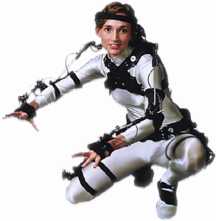Motion Capture Suits
Inertial/Mechanical Mocap Technology
The Gypsy began life as a patented exoskeleton motion capture technology called GolfMotion in 1987. It was used as a golf simulation system that became popular in Japan. During the mid-90's it evolved into a system for motion capture. In the late 90's increased accuracy was introduced via a calibration procedure. In 2000 Gypsy 3 made wide-range wireless transmission practical. In 2002 Gypsy Junior (now known as Gypsy Torso) was introduced. In May of 2004 Gypsy Gyro was released - finally realizing the original goal of the Gypsy system - super-easy and super-accurate motion capture in a free-roaming system.
Gypsy technology - a better solution
The goal behind design of the Gypsy system was to create a more natural approach to motion capture, one that would be easier and faster to use and much more affordable than conventional technologies. Additionally it had to be transportable and free from the environmental restrictions that plagued the existing magnetic and optical technologies. It also had to measure the motion of the actor's actual bones (not the motion of the suit or sensors in space) and function in real-time.
 Physical Description
Physical Description
The Gypsy is a patented electro-mechanical system consisting of an exoskeleton made of lightweight aluminum rods that follow the motion of the performer's bones. Potentiometers (variable resistors) at the joints change voltage (varying resistance) based upon angular rotation of the rods. A gyroscope (mounted in the hip piece) is used to calculate the bearing (rotational direction) of the hips.
The IGS-190 (Gypsy Gyro) system uses small solid-state Inertial Measurement Units ('gyros') attached to the body to measure the motions of the actor's skeleton.
How it works
In Gypsy 6 and Gypsy Torso, An AtoD (Analog to Digital converter) on the suit converts the analog voltage changes from the suit's various potentiometers to digital values. These digital values are transmitted to the computer where the driver software interprets this information (based upon the performer's calibration file). The data drives a skeletal representation of the performer's skeleton in real-time, in response to the performer's motions. The software can sense which foot is placed where on the ground, and it calculates footstep placement accordingly. The gyroscope's readings of hip orientation describes movement of the performer's center of mass. The result is relative variations from initialization position, which results in accurate global translations.
In the case of Gypsy Gyro, small gyroscopes attached to the actor's limbs or other body parts detect the exact motions of all the body parts to which they are attached. The angular changes are collected on the suit and transmitted to the capture computer in real-time. The included (optional) 19th gyro can be used to track the movement of swords or implements or to add much greater accuracy to the recording of the spine motion.
Calibration
In the case of Gypsy 6 and Gypsy Torso, accurately recording of the rotation of Gypsy's exoskeleton wouldn't be very useful if it weren't for the Gypsy's Inner Skeleton calculation. This Human Calibration™ involves measuring distances between joints, and offsets from the rotational centers of the potentiometers to the center of the joints. The result is highly accurate inner skeletal data, based upon virtual joints of the performer's skeleton.
An experienced Gypsy 6 operator can create a quick calibration file for a new performer in approximately 5 minutes. Once calibrated, a periodic re-initialization (instantaneous) readies the Gypsy for accurate recording.
The IGS-190 (AKA Gypsy Gyro) works well without calibration, since the rotation of the actor's skeleton can be applied directly to the 3D character's skeleton. Accuracy is greatly increased by using the Autocal process (approximately 10 minutes).